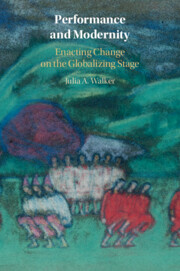Introduction - Bodies of Knowledge
Shock, Sensation, Performance, Aesthetics, Epistemology
Published online by Cambridge University Press: 09 December 2021
Summary
In an 1879 production of Shakespeare’s The Merchant of Venice, the esteemed British actor Henry Irving offered a new interpretation of Shylock, sparking a debate that roiled the London press.1 Instead of portraying the Jewish miser as a comic scapegoat as had been tradition, Irving lent dignity and pathos to the misunderstood figure, soliciting an unexpected sympathy from many in the audience.2 By all accounts, the scene that created the most striking effect was one of Irving’s own invention.
Information
- Type
- Chapter
- Information
- Performance and ModernityEnacting Change on the Globalizing Stage, pp. 1 - 18Publisher: Cambridge University PressPrint publication year: 2022
